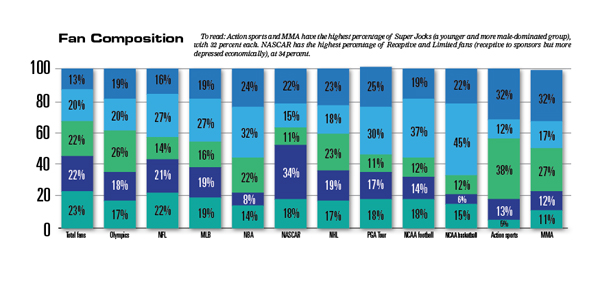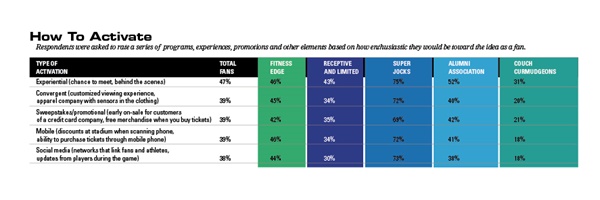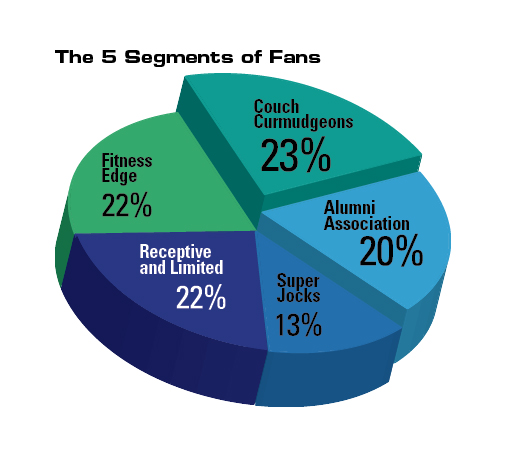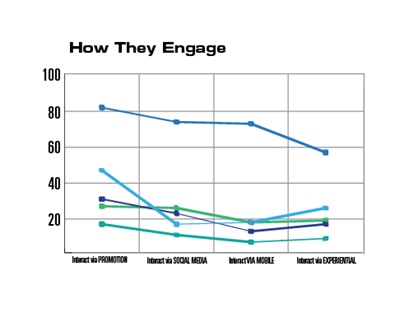Results of an expansive study scheduled to be unveiled this week aim to provide new tools for marketers to better evaluate sports fans’ emotional motivations, their purchasing and social media behavior, and their lifestyle habits both within and outside of sports.
The research is the result of a yearlong effort by marketing and consulting agency Team Epic. The data segments sports fans into five distinct clusters based on characteristics such as avidity, engagement with sponsors, socioeconomic status and personal outlook on life. According to Team Epic officials, segmentation like this will allow marketers to be more strategic in their property selection by understanding how various fan bases react to sponsors and what type of activation programs are most likely to engage them.
■ COUCH CURMUDGEONS: Oldest and least active. They prefer watching sports at home. They also are the least optimistic about the future, are the least open to sponsors and are not actively involved in sponsor programs.
■ ALUMNI ASSOCIATION: Older male sports fans with high disposable income and heavily invested in college sports. Open to sponsorship and influenced by sponsor programs (although not as much as Super Jocks).
■ SUPER JOCKS: Very young and male-dominated group with the second-highest average household income. Highly social and active, and the most likely to identify themselves as outdoor enthusiasts. They seek live events and are heavily into tailgating and fantasy sports. Very open to sponsorship and exceed all groups in their level of participation in sponsor programs.
■ RECEPTIVE AND LIMITED: Mix of male and female sports fans. Second-oldest of any segment; below-average income. Much more likely to follow pro sports and like NASCAR. Highly receptive to sponsors (viewing them as important and exhibiting good will toward them) but given their lower levels of disposable income, they are more conscious about spending money.
■ FITNESS EDGE: Most female of any group and very diverse. Younger and very physically active, with average income levels. More likely to follow pro sports and love the Olympics. Most active on social media. Have a positive view of sponsors but are selective about how they get involved in promotions, sponsor programs, etc.
“One of the most interesting findings is that fans should no longer be looked at in silos — as an ‘NHL fan’ or an ‘MLB fan,’” said Team Epic principal Mike Reisman. “Segmentation based on avidity misses the point of today’s consumers’ lifestyle and mind-set. Instead, this study shows empirically that a brand ought to be looking across the lifestyle interests of a consumer. The majority of fans are looking for brands that deliver enrichment across sports, not just for an individual sport.”
Finding the sport or sports with the highest concentration of fan clusters who are receptive to specific activations or campaigns should be a brand’s top priority, Reisman said.
For example, fans in the segment labeled the Alumni Association are more accepting of integrated sponsorships (such as the FedEx Air and Ground NFL player awards, or the Kia NBA Performance Awards), are more likely than most fans to have children at home, and are more likely to have interacted at a live sponsor event. Marketers are more likely to find a higher concentration of these fans among college football and basketball, the PGA Tour and the NBA fan bases.
Separately, two-thirds of the study’s Fitness Edge segment is female, the highest ratio of any of the five fan clusters. This group is the most active in social media, and Fitness Edge fans are more likely than most fans to respond to sponsor activation efforts that use mobile devices. Members also have a generally positive outlook on their future. Thirty-eight percent of action sports fans fit into this category, as do more than one-quarter of MMA and Olympic fans.
The survey also identifies a Super Jocks category, comprising fans who are relatively young (average age: 33.5 years) and ethnically diverse (30 percent non-white) and with the most positive outlook on their lives: 59 percent of Super Jocks say they are “extremely” or “very happy,” which is 13 percentage points above the survey’s average. Eighty-nine percent of these fans said they have interacted with sponsors online by participating in a promotion of some sort, the highest rate of any group of fans.
Interest in personal interaction, such as player meet-and-greets and behind-the-scenes tours, by this group of fans is one of the key findings of the study for CMOs, according to Jeff Eccleston, vice president and group director of Sponsorship Research International, Team Epic’s research arm.
“We set out on this research study as many marketers were trying to better understand how the consumer behaves in the ‘new age’ of sports marketing,” Eccleston said. “We discovered a treasure trove of findings, but none more so than the importance of intimacy. The delivery of ‘never been done before’ intimate moments will more likely ensure the delivery of results.”
Norwalk, Conn.-based Team Epic is a division of London-based Aegis Media and was created in 2010 with the merger of two existing Aegis entities: Velocity Sports & Entertainment and experiential marketing unit Vivid Marketing. Team Epic clients include AT&T, FedEx, IBM, Sports Illustrated, Procter & Gamble, and Samsung.
The project here stands as the first agency research effort that aims to link pyschographics with fan behavior while also considering fans’ outlook on current events and personal issues, such as income and job stability. Octagon in 2005 launched its Passion Drivers study, a research program that factors psychographics such as “sense of belonging” and “nostalgia” to quantify the emotional connection that fans have with sports, music and entertainment. The Team Epic project adds societal considerations from the respondents, such as their thoughts on the economy and on their jobs.
In the study, before any sports-related questions were posed, participants were asked to do a self-evaluation of their current personal outlook. These questions aimed to assess the 2,750 respondents on elements such as their “level of happiness” and “state of mind.” Participants also were asked to gauge how they would describe themselves now compared to recent years, considering words such as “anxious,” “hopeful,” “overwhelmed” and “relaxed.” The respondents further rated their level of concern about specific non-sports topics, such as their employment status, health care and fuel costs, and they were asked about their passions and hobbies beyond sports.
It’s at that point that the survey segued into questions regarding the participants’ attitudes toward sports and the role sports plays in their lives personally as well as in society overall. Questions involving media use, technology and sponsorship considerations followed. Sample statements for assessment included “I have no problem with sponsorship on jerseys or the field of play,” and “I get most of my sports news through social media.”
One brand-side marketer who represents a company that is not a Team Epic client, nor had he seen the results of the survey, said the more data, the better. Justin Reckamp, marketing analyst for State Farm’s national sponsorships, said understanding the mindset of consumers is key.
“State Farm looks at psychographic information while planning activation,” he said. “Our goal is to enhance the fan experience, and you have to know what is important to them emotionally in order to create impactful activations. The ability to offer a unique and customized experience to a fan that [we] otherwise would be unable to secure has been impactful for State Farm.”
Among other results of the survey:
• The study’s Receptive and Limited group is the least diverse ethnically of the five groups (91 percent white), has the lowest average household income ($46,100 annually), and its group members are more likely to be fans of NASCAR than any other sport measured in the survey.
• The Couch Curmudgeon group, the least physically active and oldest group (average age: 49.8 years), makes up 23 percent of all sports fans. These fans are more likely to be fans of the NFL than any other sport measured in the survey.
• NCAA football has a high proportion of Super Jocks (highly engaged fans) and Alumni Association consumers (sports fanatics with high net worth).









